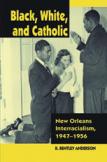A Stormy Path to Integration
Feelings regarding race run deep in the history of New Orleans. At the close of World War II, returning black G.I.’s were no longer willing to accept the many unjust racial laws or observe the many petty laws and regulations that made up daily life in the southern states. A new and different consciousness arose in the minds and hearts of African-Americans. Black Americans, including black Catholics, began to express their needs and their outrage. When some white Catholics began to articulate the church’s teaching on social justice and the dignity of all people in Christ, conflict arose with the majority of white Catholics who believed in the essential inequality of blacks and whites.
In Black, White, and Catholic, Bentley Anderson, S.J., an assistant professor of history at St. Louis University, has given us the story of how a group of determined Catholics, black and white, clergy and lay, mostly college and university students, had been won to the ideal of racial integration and social justice in the American South. This is the meaning of interracialism. The time span covers the period from the end of World War II to 1956, two years after the principle of “separate but equal,” established in the case Plessy v. Ferguson (1896), was declared unconstitutional.
The book is a fascinating history of New Orleans Catholics during the early years of desegregation. In 1939 the Catholic Committee of the South was established to bring Catholic teaching to bear on the socioeconomic problems in the south. Under the auspices of this organization, the Commission on Human Rights was established in New Orleans in 1949. A co-founder of the commission was Joseph Fichter, S.J.
Originally from New Jersey, Fichter entered the Society of Jesus in 1930, earned a doctorate in sociology from Harvard University and in 1947 began teaching sociology at Loyola University in New Orleans. From the outset he intended to bring about the desegregation of that university. He organized a seminar with students from Loyola and Xavier University (the only black Catholic institution of higher learning in the United States at the time, established by St. Katharine Drexel).
Fichter’s program of organizing people to work for the end of racial segregation was achieved through the participation of students from the various Catholic colleges in New Orleans and in Grand Coteau, who learned to work, study and play together. The National Federation of Catholic College Students, which became the Southeastern Regional Interracial Commission at Loyola, included students from Loyola, Xavier, Dominican College, Ursuline College, Sacred Heart College (Grand Coteau) and later Spring Hill College in Alabama. Most of these students were white, because Xavier was the only black college.
The young people organized monthly meetings with both African-Americans and whites; an annual interracial Sunday with Mass, breakfast and talks by both a black and a white speaker; a newsletter (published at Loyola, then suppressed); and public statements expressing opposition to presentations like minstrel shows.
Fichter faced opposition from many Jesuits at the university, including his superiors, the administration and the faculty. A smaller group of Jesuit faculty members and their colleagues stood with Fichter in opposition to racial segregation and their desire for immediate admittance of black students. A third part of the Jesuit community took a middle position, judging segregation immoral but allowable because desegregation was not possible at the time. As time went on, the Jesuit community at Loyola became more and more divided, and local superiors thought Fichter was the cause of much of the division.
The official position of the archdiocese was that segregation was immoral and contrary to justice; but Archbishop Joseph F. Rummel was a gradualist in regard to change. In 1950 the archdiocese had drawn up a policy statement doing away with segregated seating in the churches, directing priests not to refuse the sacraments or sacramentals to any black Catholic, but still urging black Catholics to frequent the black parishes. While Loyola University slowly began accepting blacks into its law school in 1952 (beginning with Norman Francis, who today is president of Xavier University), the Sisters of the Sacred Heart desegregated their college in 1953. That same year, in a pastoral letter entitled “Blessed Are the Peacemakers,” Rummel announced the end of racial segregation within the archdiocese. But the archdiocese, although it supported the Supreme Court decision, did not formally implement a policy of integration in its parochial school system until 1956. When it did, there was a storm of protest from white parishioners.
The white Catholic majority joined the White Citizens’ Councils and pushed through pro-segregation laws. In 1956 many Loyola graduates formed the Association of Catholic Laymen. Their purpose was “to foster, promote and protect the moral, physical, cultural and educational welfare…[against] integration of the black and white races….” Membership was limited to Catholics. This violent outburst of the white Catholic majority blindsided the archbishop. In response he ordered them not to declare themselves a “body of Catholic laymen.” Unfortunately, this brought to an end certain student activity. The anti-segregation student associations ceased, the activities of Fichter were curtailed, interracialism was put on hold and a chapter of the civil rights story was ended. The next chapter would belong to the Freedom Riders and Martin Luther King Jr.
Anderson’s book does a service to American church historians by revealing the contribution of black and white Catholics to the story of civil rights in the deep South. He has placed the Catholic Church in its rightful place in one of the most crucial periods of our American history. But the story is not yet ended. It remains for history to unfold further the feelings and the fears of African- American Catholics, church leaders and the white majority.
This article also appeared in print, under the headline “A Stormy Path to Integration,” in the May 8, 2006, issue.







